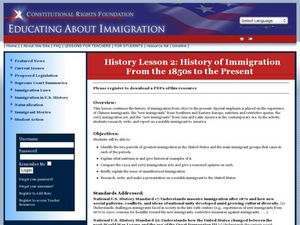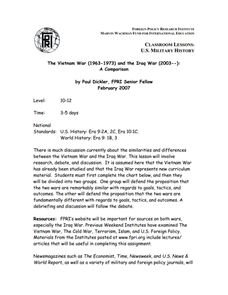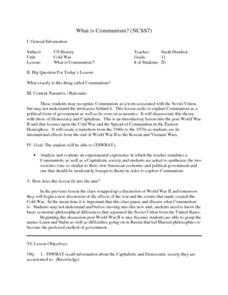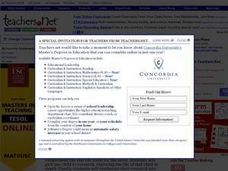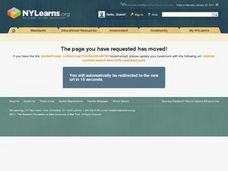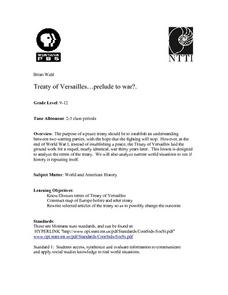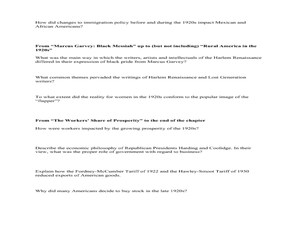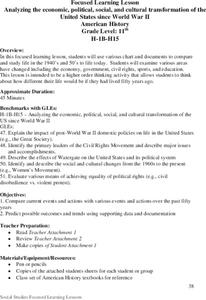Curated OER
History of Immigration From the 1850's to the Present
Eleventh graders study the history of immigration from 1850 to the present. For this American History lesson, 11th graders compare the 1924 and 1965 immigration acts and give a reasoned opinion on each. Students research,...
Curated OER
Patriotism Reflected in Art and Literature (part A)
Students explore pre-World War II Japanese art. In this patriotism lesson, students analyze Eternal Fuji and Red Sun by Yokoyama Taikan. Students discuss the techniques used to create the painting as well as the symbolism behind it....
Foreign Policy Research Institute
The Vietnam War (1963-1973) and the Iraq War (2003---): A Comparison
If you are planning a unit on military history that includes a comparison between the Vietnam War and the Iraq War, this resource may be useful. It lists possible sources for pupils to use to complete the graphic organizer which prepares...
Curated OER
Police Action: The Korean War, 1950-1953
Learners explore why the United States became involved in the war in Korea. They discuss the confict between Truman and MacArthur, culminating in the latter's dismissal from command. They identify on a world map foreign countires...
Curated OER
What is Communism?
Eleventh graders explore Communism. They explore Communism's roots in economics and discuss the spread of Communism in the Eastern Hemisphere. They evaluate a Communistic and a Capitalistic society. Students reflect upon the positives...
Curated OER
Teaching Night with Web Research Assignments
High schoolers research the Holocaust. They read the autobiography, Night, by Elie Wiesel, conduct research on a child of the Holocaust, and write an essay comparing/contrasting the life of their selected child with that of Elie Wiesel.
Curated OER
Post War Effects on Los Angeles
Eleventh graders research before and after pictures of a specific area of downtown Los Angeles. They create a poster depicting the changes.
Curated OER
Studying Oral Histories
Pupils read stories from the 1930s and 1940s. They discuss homelife during World War II. students examine changes in lifestyle and technology that may take place in the future.
Curated OER
Friends or Foes?
Students discuss Spain's relationship with Europe and the U.S. and research incidents of American-European disagreements regarding international actions and policy. They write essays on how the world might be different if a multipolar...
Curated OER
Analyzing the economic, political, social, and cultural transformation of the United States since World War II
Eleventh graders examine political issues in the United States between 1936 and 2000. In this American history lesson, 11th graders study the economy, education, government, civil rights, and sports of this time period. Students compare...
Curated OER
Bringing the Holocaust Unit to Closure: Implications For the Future
Students examine the relevance of the Holocaust to the present and future. They watch an excerpt from the movie, 'Schindler's List,' participate in a discussion of the movie excerpt, view and discuss a speech by Elie Wiesel, and write a...
Curated OER
Auschwitz Episode Guide: Factories of Death
High schoolers examine Hitler's "Final Solution." They watch and discuss a PBS documentary, read handouts, conduct Internet research, and read and discuss a personal memoir.
Curated OER
Japanese-American Relocation
Consider the causes and effects that led to the internment and relocation of Japanese Americans during WWII. Learners read the story "Baseball Saved Us" and selected chapters from Farewell to Manzanar. Then, they view a slide-show, and...
Annenberg Foundation
Global America
It's not really a small world after all! The 21st lesson of a 22-part series on American history researches the impact of globalization on the United States. Using photographic and written references materials, as well as video sources,...
Curated OER
Imperialism Political Cartoon Assessment
Students work from topics provided by the teacher to create a political cartoon that illustrates imperialism throughout the world, focusing on that which led up to World War One.
Curated OER
Land of the Rising Guns?
Students discuss the decision after World War II of Japan's to follow a policy of pacifism. After reading an article, they identify the ways Japan is strengthening its military. They watch a video to discover how their Constitution was...
Scholastic
Dear Miss Breed
This compelling plan based on the letters in the book Dear Miss Breed engages readers in learning what it was like for Japanese Americans following the attacks at Pearl Harbor. After reading the letters, young scholars will...
Curated OER
Cartoons for the Classroom: Putting a Face on Our Fears
In this current events worksheet, students analyze a political cartoon about the nuclear war threat and respond to 3 talking point questions.
Curated OER
Pearl Harbor vs September 11 Attack
High schoolers compare and contrast the events of the Pearl Harbor Attack and the attack on September 11, 2001 by examining the similarities and differences between these two events.
Curated OER
Inference
Making inferences about what you read is an important skill for both elementary, middle, and high school learners. Focusing on events which occurred during World War II, they answer a series of questions related to what we can infer as...
Curated OER
Treaty of Versailles...prelude to war?.
Students examine the Treaty of Versailles, which laid the ground work for a sequel, nearly identical, war thirty years later.
Curated OER
The American People
For this 1920's America worksheet, learners respond to 14 short answer questions about the stocks, working conditions, the Harlem Renaissance, and wealth during the decade.
Curated OER
Portraits of History
Eighth graders research the Post-Revolution to Pre-Civil War era by investigating the life and contributions of a notable person. They create silhouettes which are framed with timeline. Also, they add the research information to the...
Curated OER
Focused Learning Lesson
Eleventh graders analyze charts and primary source documents to compare life in the 1940s and 1950s. They are encouraged to examine the economy, government, sports and education.
